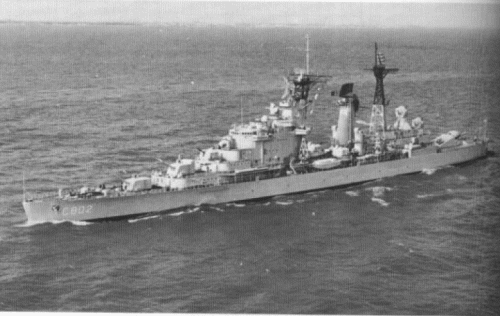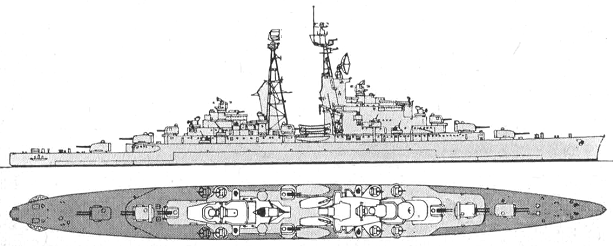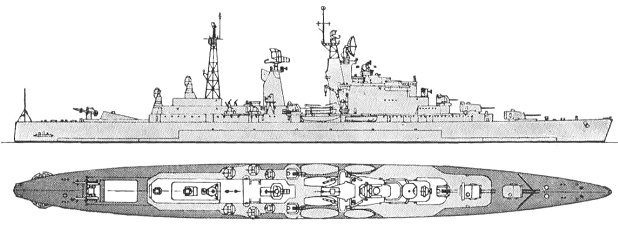
NAVYPEDIA
 Support the project with paypal
Support the project with paypal
Photo

De Zeven Provinciën Many thanks to Wolfgang Stöhr for additional information on this page.
Ships
| Name | No | Yard No | Builder | Laid down | Launched | Comp | Fate |
|---|---|---|---|---|---|---|---|
| De Ruyter (ex-De Zeven Provinciën) | C801 | 670 | Wilton-Fijenoord, Schiedam | 5.9.1939 | 24.12.1944 | 18.11.1953 | stricken 1.1973, to Peru (Almirante Grau) |
| De Zeven Provinciën (ex-Eendracht, ex-Kijkduin) | C802 | 219 | Rotterdamsche Droogdok Mij, Rotterdam | 19.5.1939 | 22.8.1950 | 17.12.1953 | stricken 10.1975, to Peru (Aguirre) |
Technical data
| Displacement standard, t | 8350 |
9529 |
|---|---|---|
| Displacement full, t | 10800 |
11850 |
| Length, m | 182.4 pp 185.7 oa |
C801: 182.4 pp 187.3 oa C802: 182.4 pp 185.7 oa |
| Breadth, m | 17.3 |
17.3 |
| Draught, m | 5.60 |
6.70 |
| No of shafts | 3 |
2 |
| Machinery | 3 sets Parsons geared steam turbines, 6 Yarrow boilers |
2 sets De Schelde-Parsons geared steam turbines, 4 Werkspoor-Yarrow boilers |
| Power, h. p. | 78000 |
85000 |
| Max speed, kts | 32 |
32 |
| Fuel, t | oil 1750 |
oil 1750? |
| Endurance, nm(kts) | 6000(12) |
7000(12) |
| Armour, mm | belt: 100 - 75, deck: 25 - 20, turrets: 100 - 50 |
belt: 75 - 50, deck: 30 - 20, turrets: 100 - 50 |
| Armament | 2 x 3 - 152/53 Bofors M42, 2 x 2 - 152/53 Bofors M42, 6 x 2 - 40/56 Bofors No.3, 4 x 2 - 12.7/62, 2 x 3 - 533 TT, 1 catapult, 2 seaplanes (C.XIVW) |
4 x 2 - 152/53 Bofors M42, 4 x 2 - 57/60 Bofors M50 |
| Electronic equipment | --- | LW-01, DA-01, VI-01, ZW-01, 2x M25, 2x M45 radars |
| Complement | 700 |
926 - 973 |
Standard scale images

Eendracht as originally planned

De Ruyter 1960

De Zeven Provinciën 1972

De Ruyter 1965

De Zeven Provinciën 1965
Graphics
Project history
Designing of ships intended for replacement of obsolete Java class light cruisers, has begun in 1930. As a design basis De Ruyter has been chosen , from which new cruiser should differ by increased on 30% displacement, strengthened protection and increase of main guns number to 10. It was originally planed to laid two ships in 1940, but means for building have been approved by parliament in 1937 and have started to be assigned next year. The order was given out to Wilton-Fijenoord, however as on it one slipway of the eligible size was free only, the second cruiser was re-ordered to Rotterdam Droogdock Mij.
It was originally planned to arm a cruiser by usual 150mm/50 guns, but then new 152mm/53 guns have been chosen, the order for designing have given out to Swedish Bofors. They should take places in four turrets arranged under superfiring scheme, with triple end turrets and twin superfiring ones. The maximum elevation angle of guns reached 60°, that on a plan could ensure shooting possibility on air targets. Thanks to last circumstance, designers have refused again an antiaircraft artillery of secondary calibre, having limited by 6 twin 40mm/56 Bofors guns. Fire control was provided by three directors: one with 6m and two with 4m rangefinders. Hangar was not provided.
Incomplete Eendracht and De Zeven Provinciën (actually, only hulls) in May, 1940 were captured on slipways by Germans, renamed KH2 and KH1 respectively and scheduled to completion after hostilities end. Hull of KH1 24.12.1944 was launched to scuttle on Rotterdam fairway, however this plan was never realised. After war both hulls were returned to the Netherlands. The artillery ordered in Sweden was installed on Swedish Tre Kronor class cruisers with new automatic loading.
In 1947 the decision on completion of the ships under the changed design was accepted, thus Eendracht was renamed De Zeven Provinciën, and De Zeven Provinciën was renamed De Ruyter.
Ships received 8 152mm automatic radar-controlled DP guns and 8 new 57mm AA guns in twin quick revolving triaxially stabilised turrets. Machinery was re-arranged under unit system: now machinery was divided into two independent units each consisting of a boiler room and engine room. As result cruisers received second funnel and two huge lattice masts for accommodation of new antennas. Superstructure was increased in twice and reconstructed. Also ships received new damage control systems, ventilation systems, new electrical plant (with AC instead of DC) and many other features.
Ship protection as originally planned
100mm armoured belt protected a hull between end barbettes and was closed by 60mm bulkheads. Ship ends were protected by narrower 75mm belt. Flat 25mm deck was connected with upper edge of the belt. Turrets had 100mm faces and 50mm protection from other directions.
Ship protection as completed
75mm armoured belt protected a hull between end barbettes and was closed by 50mm bulkheads. Ship ends were protected by narrower 50mm belt. Flat 30 - 20mm deck was connected with upper edge of the belt. Turrets had 100mm faces and 50mm protection from other directions.
Modernizations
circa 1960, both: + 8 x 1 - 40/70 Bofors M58
1964, De Zeven Provinciën: - 2 x 2 - 152/53, 1 x 2 - 57/60, 4 x 1 - 40/70, DA-01, 1x M25, 1x M45 radars; + 1 x 2 Terrier SAM launcher (40), SPS-39, 2x SPG-55 radars; displacement rose to 9850/12250t at 6.70m draught.
1972, De Zeven Provinciën: - VI-01, SPS-39 radars; + SPA-72 radar, 2x Corvus decoy RL
early 1970s, De Ruyter: - DA-01, VI-01, 2x M25 radars; + DA-02, SGR-104, 2x M20 radars.
Naval service
De Ruyter was stricken 26.1.1973 and 7.3.1973 sold to Peru as Almirante Grau. De Zeven Provinciën in 1962-1964 was converted to guided missile cruiser; 17.10.1975 she was stricken and in August, 1976 sold to Peru as Aguirre.
Many thanks to Wolfgang Stöhr for additional information on this page.
 HOME
HOME FIGHTING SHIPS OF THE WORLD
FIGHTING SHIPS OF THE WORLD NETHERLANDS
NETHERLANDS CRUISERS
CRUISERS DE RUYTER cruisers (1953)
DE RUYTER cruisers (1953)
